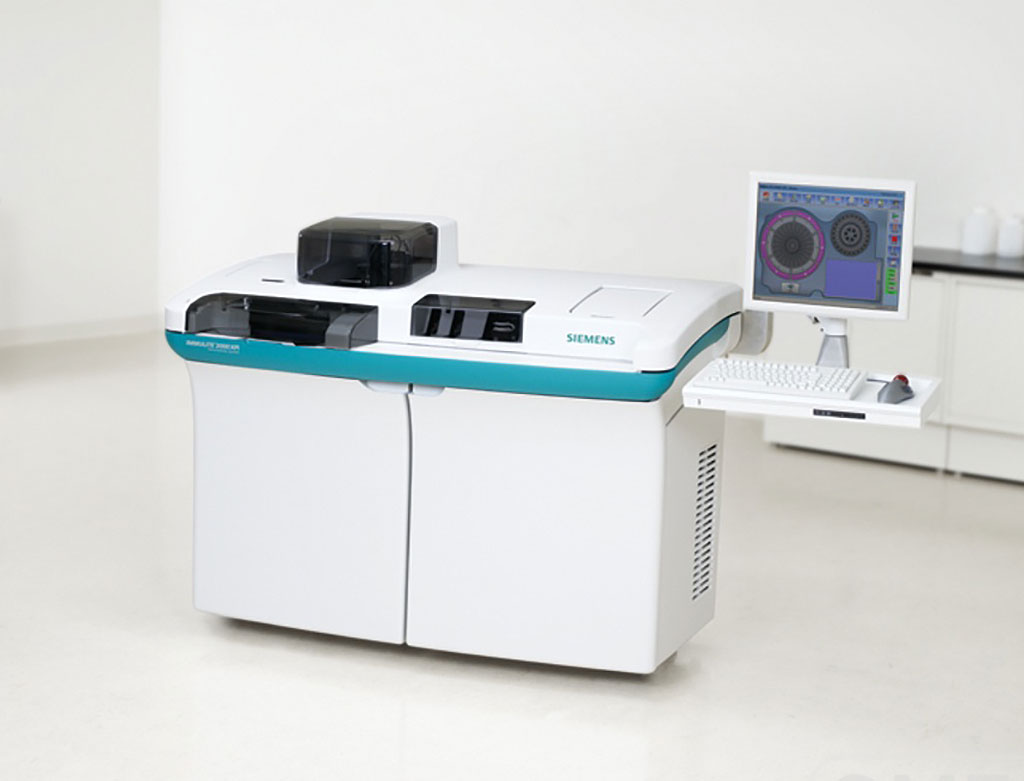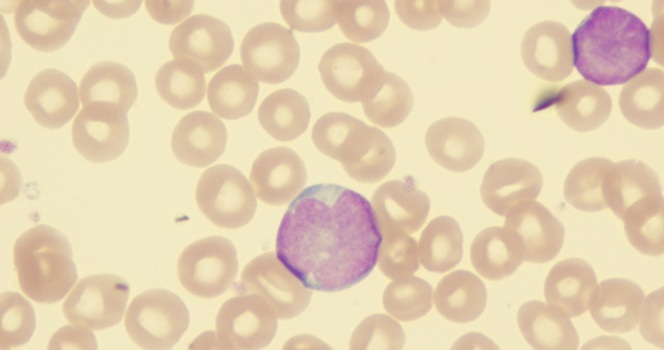Association Between Helicobacter pylori With Nonalcoholic Fatty Liver Disease Assessed
|
By LabMedica International staff writers Posted on 06 Jan 2022 |

Image: The Immulite 2000 XPI System is an easy to use, continuous random-access immunoassay analyzer with one of the largest automated immunoassay menus available (Photo courtesy of Siemens Healthcare)
Non-alcoholic fatty liver disease is closely linked to various metabolic disorders such as obesity, type 2 diabetes, and cardiovascular disease, and has been considered as a hepatic manifestation of metabolic syndrome.
Helicobacter pylori (Hp) is a Gram-negative microorganism that infects more than half of the global population. While Hp is considered to play a causative role in many gastrointestinal diseases such as chronic gastritis, peptic ulcers and gastric cancer, its role in extra-gastric diseases including metabolic syndrome, hematologic and cardiovascular diseases has also been studied.
Gastroenterologists at the Seoul National University Hospital (Seoul, Korea) conducted a retrospective cohort study of apparently healthy individuals who underwent liver Fibroscan during health screening tests between January 2018 and December 2018 and 1,784 subjects were included in the final analysis. Laboratory tests included serum total cholesterol, triglycerides, high-density lipoprotein (HDL) cholesterol, fasting glucose, and glycated hemoglobin (HbA1c).
Diagnosis of Hp infection was based on the results of a serum anti-Hp IgG antibody test using a commercially available chemiluminescent microparticle immunoassay kit, the Immulite 2000 CMIA (Siemens Healthcare GmbH, Erlangen, Germany). This is a solid-phase, two step chemiluminescent enzyme immunoassay. The Hp IgG in diluted serum sample bound with antigen-coated bead enclosed within a test unit. After removing unbound serum by centrifugation, an alkaline phosphatase-labeled anti-human IgG is introduced. Values higher than 1.10 IU/mL were considered positive. The Hp IgG kit has a sensitivity of 91% and a specificity of 100%.
The scientists reported that among the 1,784 subjects (mean age 55.3 years, 83.1% male), 708 (39.7%) subjects showed positive results of Hp serology. In the multivariate analysis, obesity (body mass index ≥25) (odds ratio [OR] 3.44, triglyceride (OR 2.31), and the highest tertile of liver stiffness measurement (OR 2.08) were found to be associated with NAFLD, defined by controlled attenuation parameter (CAP) ≥248 dB/m, while Hp-seropositivity showed no association with NAFLD. Serum levels of HDL cholesterol significantly decreased in subjects with Hp-seropositivity compared to HP-seronegativity in both groups with and without NAFLD.
The authors concluded that while Hp seropositivity was not associated with CAP-defined NAFLD, serum HDL cholesterol level were negatively associated with Hp-seropositivity in both groups with and without NAFLD. As various Hp antigens are associated differently with metabolic conditions, it would be better to verify multiple Hp antigen using multiplex serology. The study was published on December 13, 2021 in the journal PLOS ONE.
Related Links:
Seoul National University Hospital
Siemens Healthcare GmbH
Helicobacter pylori (Hp) is a Gram-negative microorganism that infects more than half of the global population. While Hp is considered to play a causative role in many gastrointestinal diseases such as chronic gastritis, peptic ulcers and gastric cancer, its role in extra-gastric diseases including metabolic syndrome, hematologic and cardiovascular diseases has also been studied.
Gastroenterologists at the Seoul National University Hospital (Seoul, Korea) conducted a retrospective cohort study of apparently healthy individuals who underwent liver Fibroscan during health screening tests between January 2018 and December 2018 and 1,784 subjects were included in the final analysis. Laboratory tests included serum total cholesterol, triglycerides, high-density lipoprotein (HDL) cholesterol, fasting glucose, and glycated hemoglobin (HbA1c).
Diagnosis of Hp infection was based on the results of a serum anti-Hp IgG antibody test using a commercially available chemiluminescent microparticle immunoassay kit, the Immulite 2000 CMIA (Siemens Healthcare GmbH, Erlangen, Germany). This is a solid-phase, two step chemiluminescent enzyme immunoassay. The Hp IgG in diluted serum sample bound with antigen-coated bead enclosed within a test unit. After removing unbound serum by centrifugation, an alkaline phosphatase-labeled anti-human IgG is introduced. Values higher than 1.10 IU/mL were considered positive. The Hp IgG kit has a sensitivity of 91% and a specificity of 100%.
The scientists reported that among the 1,784 subjects (mean age 55.3 years, 83.1% male), 708 (39.7%) subjects showed positive results of Hp serology. In the multivariate analysis, obesity (body mass index ≥25) (odds ratio [OR] 3.44, triglyceride (OR 2.31), and the highest tertile of liver stiffness measurement (OR 2.08) were found to be associated with NAFLD, defined by controlled attenuation parameter (CAP) ≥248 dB/m, while Hp-seropositivity showed no association with NAFLD. Serum levels of HDL cholesterol significantly decreased in subjects with Hp-seropositivity compared to HP-seronegativity in both groups with and without NAFLD.
The authors concluded that while Hp seropositivity was not associated with CAP-defined NAFLD, serum HDL cholesterol level were negatively associated with Hp-seropositivity in both groups with and without NAFLD. As various Hp antigens are associated differently with metabolic conditions, it would be better to verify multiple Hp antigen using multiplex serology. The study was published on December 13, 2021 in the journal PLOS ONE.
Related Links:
Seoul National University Hospital
Siemens Healthcare GmbH
Latest Pathology News
- Tunable Cell-Sorting Device Holds Potential for Multiple Biomedical Applications
- AI Tool Outperforms Doctors in Spotting Blood Cell Abnormalities
- AI Tool Rapidly Analyzes Complex Cancer Images for Personalized Treatment
- Diagnostic Technology Performs Rapid Biofluid Analysis Using Single Droplet
- Novel Technology Tracks Hidden Cancer Cells Faster
- AI Tool Improves Breast Cancer Detection
- AI Tool Predicts Treatment Success in Rectal Cancer Patients
- Blood Test and Sputum Analysis Predict Acute COPD Exacerbation
- AI Tool to Transform Skin Cancer Detection with Near-Perfect Accuracy
- Unique Immune Signatures Distinguish Rare Autoimmune Condition from Multiple Sclerosis
- Simple Optical Microscopy Method Reveals Hidden Structures in Remarkable Detail
- Hydrogel-Based Technology Isolates Extracellular Vesicles for Early Disease Diagnosis
- AI Tool Improves Accuracy of Skin Cancer Detection
- Highly Sensitive Imaging Technique Detects Myelin Damage
- 3D Genome Mapping Tool to Improve Diagnosis and Treatment of Genetic Diseases
- New Molecular Analysis Tool to Improve Disease Diagnosis
Channels
Clinical Chemistry
view channel
Chemical Imaging Probe Could Track and Treat Prostate Cancer
Prostate cancer remains a leading cause of illness and death among men, with many patients eventually developing resistance to standard hormone-blocking therapies. These drugs often lose effectiveness... Read more
Mismatch Between Two Common Kidney Function Tests Indicates Serious Health Problems
Creatinine has long been the standard for measuring kidney filtration, while cystatin C — a protein produced by all human cells — has been recommended as a complementary marker because it is influenced... Read moreMolecular Diagnostics
view channel
Simple Urine Test to Revolutionize Bladder Cancer Diagnosis and Treatment
Bladder cancer is one of the most common and deadly urological cancers and is marked by a high rate of recurrence. Diagnosis and follow-up still rely heavily on invasive cystoscopy or urine cytology, which... Read more
Blood Test to Enable Earlier and Simpler Detection of Liver Fibrosis
Persistent liver damage caused by alcohol misuse or viral infections can trigger liver fibrosis, a condition in which healthy tissue is gradually replaced by collagen fibers. Even after successful treatment... Read moreHematology
view channel
Platelet Activity Blood Test in Middle Age Could Identify Early Alzheimer’s Risk
Early detection of Alzheimer’s disease remains one of the biggest unmet needs in neurology, particularly because the biological changes underlying the disorder begin decades before memory symptoms appear.... Read more
Microvesicles Measurement Could Detect Vascular Injury in Sickle Cell Disease Patients
Assessing disease severity in sickle cell disease (SCD) remains challenging, especially when trying to predict hemolysis, vascular injury, and risk of complications such as vaso-occlusive crises.... Read more
ADLM’s New Coagulation Testing Guidance to Improve Care for Patients on Blood Thinners
Direct oral anticoagulants (DOACs) are one of the most common types of blood thinners. Patients take them to prevent a host of complications that could arise from blood clotting, including stroke, deep... Read moreImmunology
view channel
New Test Distinguishes Vaccine-Induced False Positives from Active HIV Infection
Since HIV was identified in 1983, more than 91 million people have contracted the virus, and over 44 million have died from related causes. Today, nearly 40 million individuals worldwide live with HIV-1,... Read more
Gene Signature Test Predicts Response to Key Breast Cancer Treatment
DK4/6 inhibitors paired with hormone therapy have become a cornerstone treatment for advanced HR+/HER2– breast cancer, slowing tumor growth by blocking key proteins that drive cell division.... Read more
Chip Captures Cancer Cells from Blood to Help Select Right Breast Cancer Treatment
Ductal carcinoma in situ (DCIS) accounts for about a quarter of all breast cancer cases and generally carries a good prognosis. This non-invasive form of the disease may or may not become life-threatening.... Read moreMicrobiology
view channel
Rapid Diagnostic Test Matches Gold Standard for Sepsis Detection
Sepsis kills 11 million people worldwide every year and generates massive healthcare costs. In the USA and Europe alone, sepsis accounts for USD 100 billion in annual hospitalization expenses.... Read moreRapid POC Tuberculosis Test Provides Results Within 15 Minutes
Tuberculosis remains one of the world’s deadliest infectious diseases, and reducing new cases depends on identifying individuals with latent infection before it progresses. Current diagnostic tools often... Read more
Rapid Assay Identifies Bloodstream Infection Pathogens Directly from Patient Samples
Bloodstream infections in sepsis progress quickly and demand rapid, precise diagnosis. Current blood-culture methods often take one to five days to identify the pathogen, leaving clinicians to treat blindly... Read moreTechnology
view channel
Artificial Intelligence Model Could Accelerate Rare Disease Diagnosis
Identifying which genetic variants actually cause disease remains one of the biggest challenges in genomic medicine. Each person carries tens of thousands of DNA changes, yet only a few meaningfully alter... Read more
AI Saliva Sensor Enables Early Detection of Head and Neck Cancer
Early detection of head and neck cancer remains difficult because the disease produces few or no symptoms in its earliest stages, and lesions often lie deep within the head or neck, where biopsy or endoscopy... Read moreIndustry
view channel
Abbott Acquires Cancer-Screening Company Exact Sciences
Abbott (Abbott Park, IL, USA) has entered into a definitive agreement to acquire Exact Sciences (Madison, WI, USA), enabling it to enter and lead in fast-growing cancer diagnostics segments.... Read more




 assay.jpg)
















